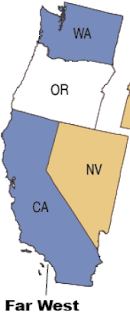A population group, geographic area, or facility where residents have limited access to basic medical care because it has too few primary care physicians relative to the size of its population can be designated a health professional shortage area (HPSA) by the Health Resources and Services Administration (HRSA). As of December 31, 2022, the HRSA reported that more than 98.5 million Americans lived in areas or settings designated as primary care HPSAs. The six-state Far West region accounted for about 15.7% of Americans who lived in primary care shortage areas. The HRSA estimates that to eliminate the shortage Far West region HPSAs would need 2,765 additional primary care physicians. As such, the Far West accounted for about 16.2% of the national deficit of primary care physicians. A closer review of 12/31/22 HRSA data reveals the following about the Far West's primary care shortage:

|
The Far West's Primary Care Shortage |
| State |
(1) HPSAs |
(2) Population |
(3) Shortage |
| AK |
325 |
295,674 |
74 |
| CA |
682 |
8,260,869 |
1,380 |
| HI |
32 |
519,102 |
87 |
| NV |
77 |
1,238,467 |
236 |
| OR |
174 |
1,577,773 |
194 |
| WA |
225 |
3,542,702 |
794 |
|
|
|
|
| Region |
1,515 |
15,434,587 |
2,765 |
|
|
|
|
| U.S. |
8,294 |
98,537,257 |
17,065 |
|
|
|
|
| % of U.S. |
18.3% |
15.7% |
16.2% |
(1) Designated Geographic, Population Group, and Facility HPSAs with a primary care shortage
(2) Population of designated HPSAs
(3) Primary Care practitioners needed to remove HPSA Designation
Source: Designated HPSA Quarterly Summary, 12/31/22 (HRSA)
